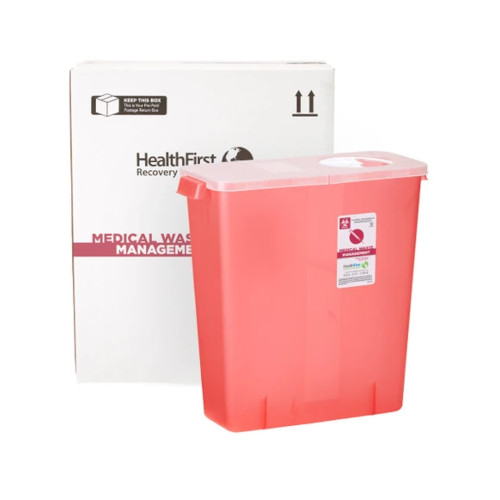Medical Waste Removal Quality: Your Trusted Partner in Safe Biohazard Disposal
Medical Waste Removal Quality: Your Trusted Partner in Safe Biohazard Disposal
Blog Article
Checking Out Various Garbage Disposal Options for a Cleanser Environment
In the search of a cleaner environment, the administration of waste disposal has actually emerged as a critical focal factor for sustainable growth. With a wide range of waste disposal choices readily available, ranging from standard land fill approaches to cutting-edge waste-to-energy modern technologies, the choice of just how we manage our waste has far-reaching ramifications for our planet's wellness.
Recycling Approaches
Implementing effective recycling methods is vital in reducing waste and advertising sustainability in our environment. Reusing includes the procedure of converting waste materials into multiple-use items to prevent unnecessary disposal. One of one of the most common recycling techniques is worldly recovery, where materials like paper, plastic, metal, and glass are collected, sorted, and refined to develop brand-new products. This procedure not just preserves natural resources yet additionally lowers energy consumption and greenhouse gas emissions related to generating brand-new products from the ground up.
One more essential recycling technique is composting, which entails decomposing natural waste like food scraps and backyard trimmings right into nutrient-rich dirt. This process not only draws away organic waste from land fills however also produces a beneficial source for horticulture and agriculture. Furthermore, upcycling is a creative recycling method that involves transforming old or thrown out products into products of higher quality or worth. By integrating these different recycling methods into our waste administration techniques, we can significantly minimize our environmental footprint and move in the direction of an extra lasting future.

Composting Methods
Efficient waste administration practices, such as reusing approaches, lead the means for a cleaner environment, and now, shifting the emphasis to 'Composting Techniques', we check out sustainable methods to decompose natural waste for ecological advantage. medical waste removal service.
Composting is an all-natural procedure that changes natural waste, like food scraps and yard trimmings, into a nutrient-rich soil modification. The key to successful composting lies in producing the ideal equilibrium of green materials, such as fruit and vegetable scraps, and brownish products, like dried twigs and leaves. These products break down with the aid of microorganisms, breaking down the waste into valuable compost.
Standard backyard composting involves layering natural materials in a container or pile and on a regular basis transforming the mixture to aerate it. By making use of composting methods, we can reduce the quantity of waste sent to garbage dumps while creating a valuable product for enhancing soil and sustaining plant development.
Incineration Cons and pros
Incineration, as a garbage disposal method, offers both benefits and disadvantages that warrant cautious factor to consider in the realm of lasting waste management practices. On the silver lining, incineration can substantially lower the volume of waste, reducing the need for garbage dump room and potentially lowering greenhouse gas emissions. Incineration likewise permits for the healing of energy with the generation of power or heat, contributing to source recovery. Moreover, the process can be utilized to damage harmful compounds, offering a secure approach for managing particular kinds of waste that might position threats to public wellness and the setting if left unattended.
Nonetheless, there are remarkable downsides to incineration. One major problem is the potential release of click for source damaging toxins right into the air, such as dioxins, heavy steels, and particulate matter, which can have negative results on human wellness and the setting. In addition, the high first investment and functional prices of incineration centers position economic difficulties, making it a much less affordable option contrasted to other waste monitoring strategies. Cautious surveillance and regulation are important to minimize these adverse influences and maximize the advantages of incineration as part of a comprehensive waste administration method.
Landfill Administration Approaches
Landfills play a critical function in waste management and ecological preservation by offering a control system for the disposal of strong waste products. Efficient landfill monitoring approaches are vital to mitigate ecological influences and guarantee the long-lasting sustainability of these waste disposal websites. One vital approach appertains waste compaction to take full advantage of making use of available area within the landfill (click here). By compacting the waste, the volume is reduced, allowing for more waste to be fit gradually.
Furthermore, the execution of daily cover techniques is vital in reducing odors, avoiding trash, and lowering the tourist attraction of insects. Covering the disposed waste at the end of every day assists to consist of odors and stop prospective ecological contamination. In addition, the monitoring of land fill gas discharges and leachate degrees is crucial in making certain that environmental criteria are satisfied which any kind of prospective risks to bordering environments are lessened.

Waste-to-Energy Technologies
One of the ingenious techniques to waste monitoring entails utilizing Waste-to-Energy technologies to transform solid waste into functional energy resources. Waste-to-Energy (WtE) technologies incorporate a variety of procedures that intend to extract power from waste products via thermal, chemical, or organic methods. This conversion process not only decreases the volume of waste that ends up in landfills yet additionally creates beneficial power resources such as power, warmth, or biofuels.
There are numerous methods of Waste-to-Energy conversion, including gasification, pyrolysis, and incineration. Incineration includes shedding waste at heats to produce warm and power. Gasification converts waste into a syngas, which can be made use of for power generation or chemical manufacturing. Pyrolysis breaks down natural materials utilizing high temperatures in the absence of oxygen, generating gas, bio-oil, and char.
Carrying out Waste-to-Energy technologies can aid alleviate environmental concerns connected with typical waste disposal techniques while concurrently providing a renewable resource resource. Nevertheless, careful consideration must be offered to exhausts control and making sure the sustainability of feedstock supplies for these technologies to be absolutely valuable for a cleaner atmosphere.

Conclusion
To conclude, discovering numerous waste disposal options such as recycling, composting, incineration, land fill management, and waste-to-energy innovations is crucial for promoting a cleaner environment - click here. Each method has its very own benefits and obstacles, but by utilizing a combination of these techniques, we can work towards minimizing the quantity of waste that finishes up in land fills and ultimately contribute to an extra sustainable future for generations to come
With a wide range of waste disposal choices readily available, varying from typical garbage dump techniques to cutting-edge waste-to-energy modern technologies, the choice of how we handle our waste has far-ranging effects for our world's health. medical waste disposal.Incineration, as a waste disposal method, offers both benefits and negative aspects that warrant careful consideration in the world of sustainable waste monitoring techniques.Land fills play a crucial duty in waste monitoring and ecological conservation by offering a containment system for the disposal of solid waste materials. By condensing the waste, the quantity is decreased, allowing for even more waste to be accommodated over time
One of the innovative methods to waste monitoring includes taking advantage of Waste-to-Energy innovations to convert solid waste into useful energy sources.
Report this page